check engine light Alfa Romeo 156 2006 Owner handbook (in English)
[x] Cancel search | Manufacturer: ALFA ROMEO, Model Year: 2006, Model line: 156, Model: Alfa Romeo 156 2006Pages: 357, PDF Size: 5.04 MB
Page 161 of 357
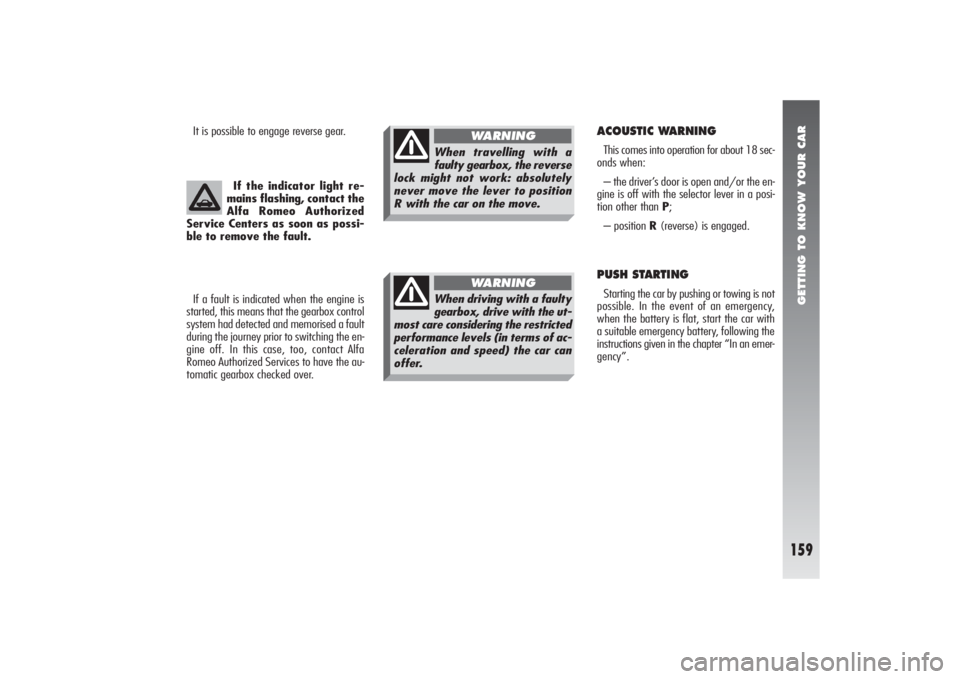
GETTING TO KNOW YOUR CAR
159
If the indicator light re-
mains flashing, contact the
Alfa Romeo Authorized
Service Centers as soon as possi-
ble to remove the fault.
If a fault is indicated when the engine is
started, this means that the gearbox control
system had detected and memorised a fault
during the journey prior to switching the en-
gine off. In this case, too, contact Alfa
Romeo Authorized Services to have the au-
tomatic gearbox checked over.It is possible to engage reverse gear.
ACOUSTIC WARNINGThis comes into operation for about 18 sec-
onds when:
– the driver’s door is open and/or the en-
gine is off with the selector lever in a posi-
tion other than P;
– position R(reverse) is engaged.PUSH STARTINGStarting the car by pushing or towing is not
possible. In the event of an emergency,
when the battery is flat, start the car with
a suitable emergency battery, following the
instructions given in the chapter “In an emer-
gency”.
When driving with a faulty
gearbox, drive with the ut-
most care considering the restricted
performance levels (in terms of ac-
celeration and speed) the car can
offer.
WARNING
When travelling with a
faulty gearbox, the reverse
lock might not work: absolutely
never move the lever to position
R with the car on the move.
WARNING
Page 180 of 357

GETTING TO KNOW YOUR CAR
178
Braking on corners always requires the ut-
most caution, even with the help of the ABS.
The most important piece of advice, how-
ever, is the following:Following these instructions you will be
in a condition to obtain peak braking per-
formance at all times.
WARNINGCars fitted with ABS must
only be fitted with wheel rims, tyres and
brake linings of the type and brand approved
by the Manufacturer.
The braking system is completed by the
electronic control braking distribution system
called EBD(Electronic Braking Force Dis-
tributor) which distributes the braking action
through the ABSsystem control unit and
sensors.
In the event of a system
fault, with lighting up of
the
>
warning light on the instru-
ment cluster (together with the
message + symbol shown by the
display), have the vehicle checked
immediately by Alfa Romeo Au-
thorized Services, driving slowly
to be able to regain full system
performance.
WARNING
When the ABS cuts in and
you feel the pedal pulse, do
not reduce the pressure, but keep
the brake pedal firmly pressed
with no fear; this way you will
stop in the shortest possible space,
compatibly with the conditions of
the road surface.
WARNING
The car is fitted with an
electronic brake distributor
(EBD). If the
>
and
x
warning
lights, where required, come on at
the same time (together with the
message + symbol shown by the
display) when the engine is run-
ning, there is an EBD system fault;
in this case, violent braking may
lock the rear wheels too early, with
the possibility of skidding. Drive
extremely carefully to the nearest
Alfa Romeo Authorized Services to
have the system checked over.
WARNING
In order to be able to exploit as far as pos-
sible the possibility of the antilock system
in the case of need, it is wise to follow a few
pieces of advice:
The ABS exploits the avail-
able grip in full, but it can-
not increase it; therefore, caution
is required on slippery surfaces,
without running unnecessary risks.
WARNING
If the ABS cuts in, it means
that the grip limit between
the tyres and the road surface has
been reached: it is necessary to
slow down and adapt driving to
the grip available.
WARNING
Page 181 of 357
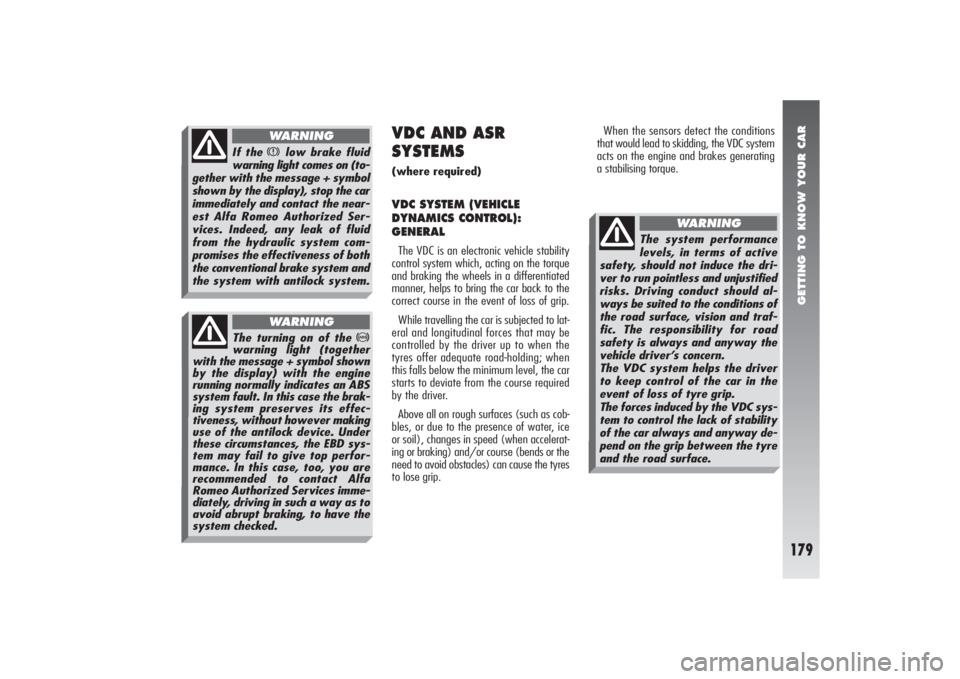
GETTING TO KNOW YOUR CAR
179
If the
x
low brake fluid
warning light comes on (to-
gether with the message + symbol
shown by the display), stop the car
immediately and contact the near-
est Alfa Romeo Authorized Ser-
vices. Indeed, any leak of fluid
from the hydraulic system com-
promises the effectiveness of both
the conventional brake system and
the system with antilock system.
WARNING
The turning on of the
>
warning light (together
with the message + symbol shown
by the display) with the engine
running normally indicates an ABS
system fault. In this case the brak-
ing system preserves its effec-
tiveness, without however making
use of the antilock device. Under
these circumstances, the EBD sys-
tem may fail to give top perfor-
mance. In this case, too, you are
recommended to contact Alfa
Romeo Authorized Services imme-
diately, driving in such a way as to
avoid abrupt braking, to have the
system checked.
WARNING
VDC AND ASR
SYSTEMS(where required)VDC SYSTEM (VEHICLE
DYNAMICS CONTROL):
GENERALThe VDC is an electronic vehicle stability
control system which, acting on the torque
and braking the wheels in a differentiated
manner, helps to bring the car back to the
correct course in the event of loss of grip.
While travelling the car is subjected to lat-
eral and longitudinal forces that may be
controlled by the driver up to when the
tyres offer adequate road-holding; when
this falls below the minimum level, the car
starts to deviate from the course required
by the driver.
Above all on rough surfaces (such as cob-
bles, or due to the presence of water, ice
or soil), changes in speed (when accelerat-
ing or braking) and/or course (bends or the
need to avoid obstacles) can cause the tyres
to lose grip.When the sensors detect the conditions
that would lead to skidding, the VDC system
acts on the engine and brakes generating
a stabilising torque.
The system performance
levels, in terms of active
safety, should not induce the dri-
ver to run pointless and unjustified
risks. Driving conduct should al-
ways be suited to the conditions of
the road surface, vision and traf-
fic. The responsibility for road
safety is always and anyway the
vehicle driver’s concern.
The VDC system helps the driver
to keep control of the car in the
event of loss of tyre grip.
The forces induced by the VDC sys-
tem to control the lack of stability
of the car always and anyway de-
pend on the grip between the tyre
and the road surface.
WARNING
Page 184 of 357
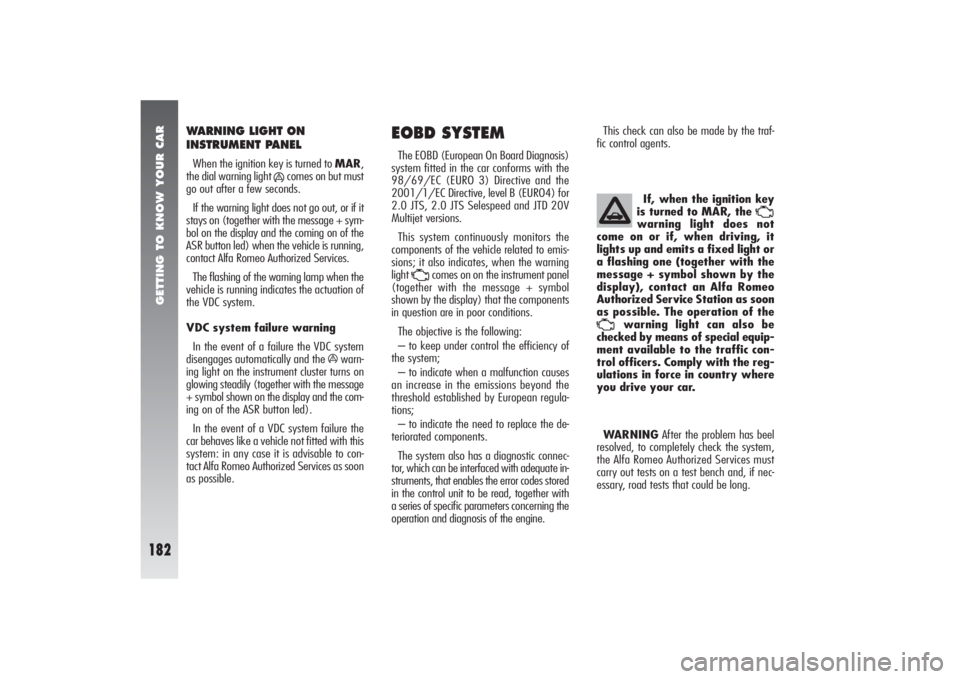
GETTING TO KNOW YOUR CAR
182
EOBD SYSTEMThe EOBD (European On Board Diagnosis)
system fitted in the car conforms with the
98/69/EC (EURO 3) Directive and the
2001/1/EC Directive, level B (EURO4) for
2.0 JTS, 2.0 JTS Selespeed and JTD 20V
Multijet versions.
This system continuously monitors the
components of the vehicle related to emis-
sions; it also indicates, when the warning
light
U
comes on on the instrument panel
(together with the message + symbol
shown by the display) that the components
in question are in poor conditions.
The objective is the following:
– to keep under control the efficiency of
the system;
– to indicate when a malfunction causes
an increase in the emissions beyond the
threshold established by European regula-
tions;
– to indicate the need to replace the de-
teriorated components.
The system also has a diagnostic connec-
tor, which can be interfaced with adequate in-
struments, that enables the error codes stored
in the control unit to be read, together with
a series of specific parameters concerning the
operation and diagnosis of the engine.This check can also be made by the traf-
fic control agents.
If, when the ignition key
is turned to MAR, the
U
warning light does not
come on or if, when driving, it
lights up and emits a fixed light or
a flashing one (together with the
message + symbol shown by the
display), contact an Alfa Romeo
Authorized Service Station as soon
as possible. The operation of the
U
warning light can also be
checked by means of special equip-
ment available to the traffic con-
trol officers. Comply with the reg-
ulations in force in country where
you drive your car.
WARNINGAfter the problem has beel
resolved, to completely check the system,
the Alfa Romeo Authorized Services must
carry out tests on a test bench and, if nec-
essary, road tests that could be long.
WARNING LIGHT ON
INSTRUMENT PANELWhen the ignition key is turned to MAR,
the dial warning light
á
comes on but must
go out after a few seconds.
If the warning light does not go out, or if it
stays on (together with the message + sym-
bol on the display and the coming on of the
ASR button led) when the vehicle is running,
contact Alfa Romeo Authorized Services.
The flashing of the warning lamp when the
vehicle is running indicates the actuation of
the VDC system.
VDC system failure warning
In the event of a failure the VDC system
disengages automatically and the
á
warn-
ing light on the instrument cluster turns on
glowing steadily (together with the message
+ symbol shown on the display and the com-
ing on of the ASR button led).
In the event of a VDC system failure the
car behaves like a vehicle not fitted with this
system: in any case it is advisable to con-
tact Alfa Romeo Authorized Services as soon
as possible.
Page 193 of 357
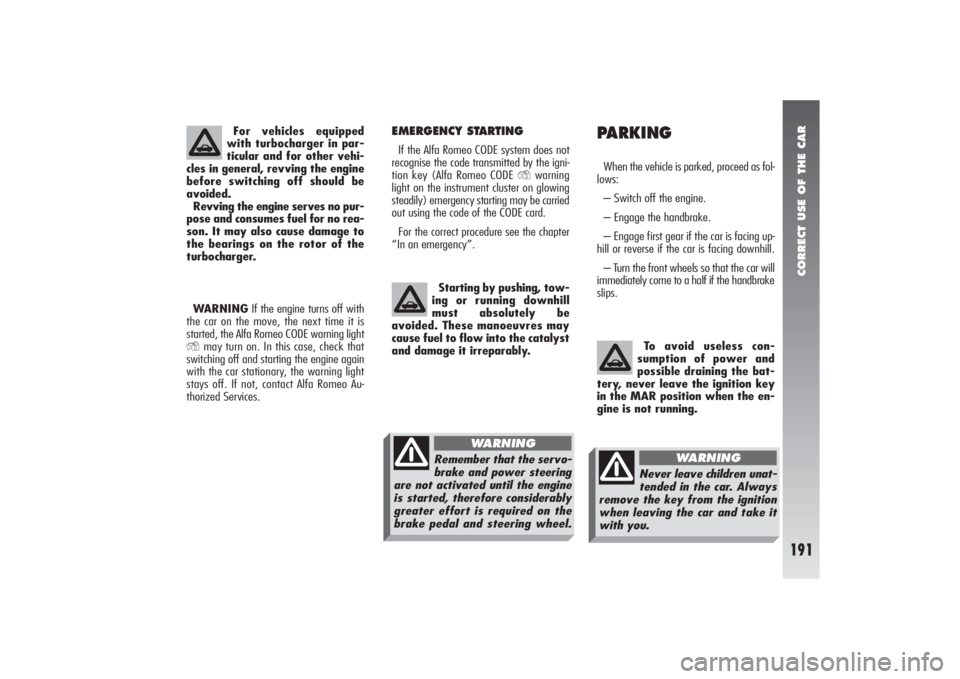
CORRECT USE OF THE CAR
191
EMERGENCY STARTINGIf the Alfa Romeo CODE system does not
recognise the code transmitted by the igni-
tion key (Alfa Romeo CODE
Y
warning
light on the instrument cluster on glowing
steadily) emergency starting may be carried
out using the code of the CODE card.
For the correct procedure see the chapter
“In an emergency”.
PARKINGWhen the vehicle is parked, proceed as fol-
lows:
– Switch off the engine.
– Engage the handbrake.
– Engage first gear if the car is facing up-
hill or reverse if the car is facing downhill.
– Turn the front wheels so that the car will
immediately come to a half if the handbrake
slips. Starting by pushing, tow-
ing or running downhill
must absolutely be
avoided. These manoeuvres may
cause fuel to flow into the catalyst
and damage it irreparably.
To avoid useless con-
sumption of power and
possible draining the bat-
tery, never leave the ignition key
in the MAR position when the en-
gine is not running.
For vehicles equipped
with turbocharger in par-
ticular and for other vehi-
cles in general, revving the engine
before switching off should be
avoided.
Revving the engine serves no pur-
pose and consumes fuel for no rea-
son. It may also cause damage to
the bearings on the rotor of the
turbocharger.
WARNINGIf the engine turns off with
the car on the move, the next time it is
started, the Alfa Romeo CODE warning lightY
may turn on. In this case, check that
switching off and starting the engine again
with the car stationary, the warning light
stays off. If not, contact Alfa Romeo Au-
thorized Services.
Remember that the servo-
brake and power steering
are not activated until the engine
is started, therefore considerably
greater effort is required on the
brake pedal and steering wheel.
WARNING
Never leave children unat-
tended in the car. Always
remove the key from the ignition
when leaving the car and take it
with you.
WARNING
Page 194 of 357
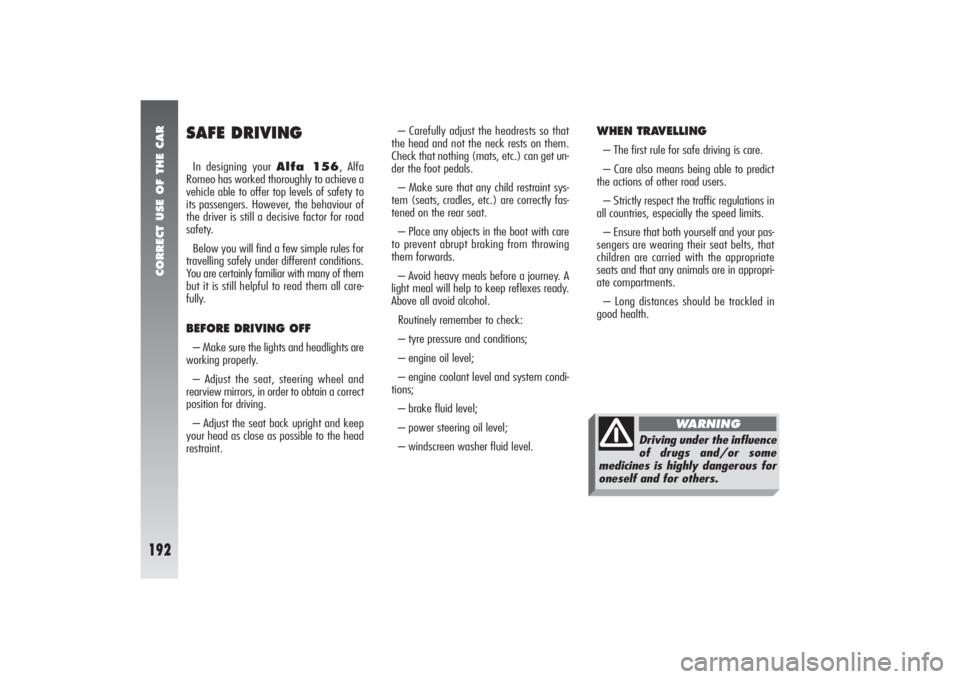
CORRECT USE OF THE CAR
192
SAFE DRIVINGIn designing your Alfa 156, Alfa
Romeo has worked thoroughly to achieve a
vehicle able to offer top levels of safety to
its passengers. However, the behaviour of
the driver is still a decisive factor for road
safety.
Below you will find a few simple rules for
travelling safely under different conditions.
You are certainly familiar with many of them
but it is still helpful to read them all care-
fully.BEFORE DRIVING OFF– Make sure the lights and headlights are
working properly.
– Adjust the seat, steering wheel and
rearview mirrors, in order to obtain a correct
position for driving.
– Adjust the seat back upright and keep
your head as close as possible to the head
restraint.– Carefully adjust the headrests so that
the head and not the neck rests on them.
Check that nothing (mats, etc.) can get un-
der the foot pedals.
– Make sure that any child restraint sys-
tem (seats, cradles, etc.) are correctly fas-
tened on the rear seat.
– Place any objects in the boot with care
to prevent abrupt braking from throwing
them forwards.
– Avoid heavy meals before a journey. A
light meal will help to keep reflexes ready.
Above all avoid alcohol.
Routinely remember to check:
– tyre pressure and conditions;
– engine oil level;
– engine coolant level and system condi-
tions;
– brake fluid level;
– power steering oil level;
– windscreen washer fluid level.
WHEN TRAVELLING– The first rule for safe driving is care.
– Care also means being able to predict
the actions of other road users.
– Strictly respect the traffic regulations in
all countries, especially the speed limits.
– Ensure that both yourself and your pas-
sengers are wearing their seat belts, that
children are carried with the appropriate
seats and that any animals are in appropri-
ate compartments.
– Long distances should be trackled in
good health.
Driving under the influence
of drugs and/or some
medicines is highly dangerous for
oneself and for others.
WARNING
Page 196 of 357
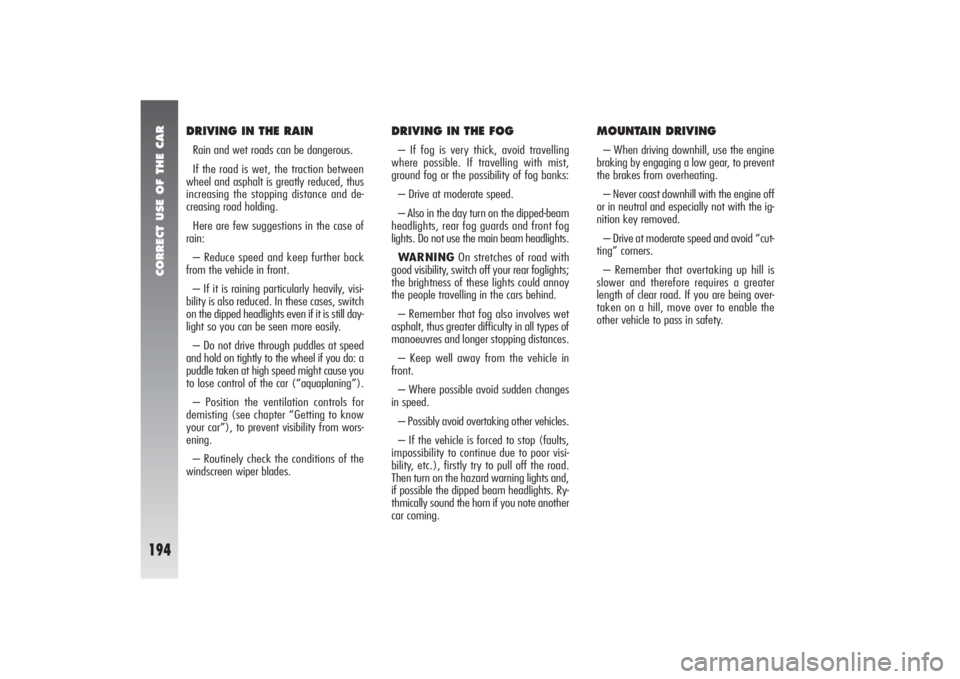
CORRECT USE OF THE CAR
194
DRIVING IN THE RAINRain and wet roads can be dangerous.
If the road is wet, the traction between
wheel and asphalt is greatly reduced, thus
increasing the stopping distance and de-
creasing road holding.
Here are few suggestions in the case of
rain:
– Reduce speed and keep further back
from the vehicle in front.
– If it is raining particularly heavily, visi-
bility is also reduced. In these cases, switch
on the dipped headlights even if it is still day-
light so you can be seen more easily.
– Do not drive through puddles at speed
and hold on tightly to the wheel if you do: a
puddle taken at high speed might cause you
to lose control of the car (“aquaplaning”).
– Position the ventilation controls for
demisting (see chapter “Getting to know
your car”), to prevent visibility from wors-
ening.
– Routinely check the conditions of the
windscreen wiper blades.
DRIVING IN THE FOG– If fog is very thick, avoid travelling
where possible. If travelling with mist,
ground fog or the possibility of fog banks:
– Drive at moderate speed.
– Also in the day turn on the dipped-beam
headlights, rear fog guards and front fog
lights. Do not use the main beam headlights.
WARNINGOn stretches of road with
good visibility, switch off your rear foglights;
the brightness of these lights could annoy
the people travelling in the cars behind.
– Remember that fog also involves wet
asphalt, thus greater difficulty in all types of
manoeuvres and longer stopping distances.
– Keep well away from the vehicle in
front.
– Where possible avoid sudden changes
in speed.
– Possibly avoid overtaking other vehicles.
– If the vehicle is forced to stop (faults,
impossibility to continue due to poor visi-
bility, etc.), firstly try to pull off the road.
Then turn on the hazard warning lights and,
if possible the dipped beam headlights. Ry-
thmically sound the horn if you note another
car coming.
MOUNTAIN DRIVING– When driving downhill, use the engine
braking by engaging a low gear, to prevent
the brakes from overheating.
– Never coast downhill with the engine off
or in neutral and especially not with the ig-
nition key removed.
– Drive at moderate speed and avoid “cut-
ting” corners.
– Remember that overtaking up hill is
slower and therefore requires a greater
length of clear road. If you are being over-
taken on a hill, move over to enable the
other vehicle to pass in safety.
Page 198 of 357
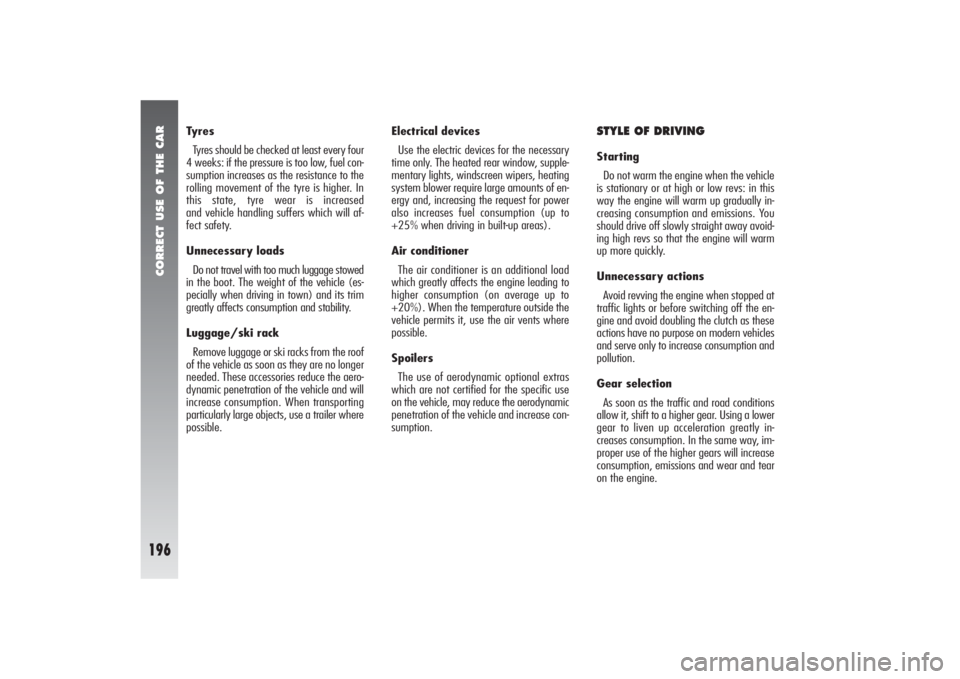
CORRECT USE OF THE CAR
196
Tyres
Tyres should be checked at least every four
4 weeks: if the pressure is too low, fuel con-
sumption increases as the resistance to the
rolling movement of the tyre is higher. In
this state, tyre wear is increased
and vehicle handling suffers which will af-
fect safety.
Unnecessary loads
Do not travel with too much luggage stowed
in the boot. The weight of the vehicle (es-
pecially when driving in town) and its trim
greatly affects consumption and stability.
Luggage/ski rack
Remove luggage or ski racks from the roof
of the vehicle as soon as they are no longer
needed. These accessories reduce the aero-
dynamic penetration of the vehicle and will
increase consumption. When transporting
particularly large objects, use a trailer where
possible.Electrical devices
Use the electric devices for the necessary
time only. The heated rear window, supple-
mentary lights, windscreen wipers, heating
system blower require large amounts of en-
ergy and, increasing the request for power
also increases fuel consumption (up to
+25% when driving in built-up areas).
Air conditioner
The air conditioner is an additional load
which greatly affects the engine leading to
higher consumption (on average up to
+20%). When the temperature outside the
vehicle permits it, use the air vents where
possible.
Spoilers
The use of aerodynamic optional extras
which are not certified for the specific use
on the vehicle, may reduce the aerodynamic
penetration of the vehicle and increase con-
sumption.
STYLE OF DRIVINGStarting
Do not warm the engine when the vehicle
is stationary or at high or low revs: in this
way the engine will warm up gradually in-
creasing consumption and emissions. You
should drive off slowly straight away avoid-
ing high revs so that the engine will warm
up more quickly.
Unnecessary actions
Avoid revving the engine when stopped at
traffic lights or before switching off the en-
gine and avoid doubling the clutch as these
actions have no purpose on modern vehicles
and serve only to increase consumption and
pollution.
Gear selection
As soon as the traffic and road conditions
allow it, shift to a higher gear. Using a lower
gear to liven up acceleration greatly in-
creases consumption. In the same way, im-
proper use of the higher gears will increase
consumption, emissions and wear and tear
on the engine.
Page 205 of 357

CORRECT USE OF THE CAR
203
Keep your speed
down when snow
chains are fitted.
Do not exceed 50 km/h. Avoid
potholes, steps and pavements and
avoid also to drive for long dis-
tances on roads not covered with
snow to prevent damaging the car
and the roadbed.
VEHICLE INACTIVITYIf the car is to be left inactive for long pe-
riods, the following precautions should be
noted:
– House the vehicle under cover in a dry
and possibly ventilated place.
– Engage a gear.
– Check that the handbrake is not en-
gaged.
– Clean and protect the painted parts us-
ing protective wax.
– Disconnect the negative terminal (–)
and check the battery charge. This check is
to be repeated every three months.
Recharge if the optical indicator shows a
dark colour without the central green area.
WARNINGWhere applicable, switch off
the electronic car alarm with the remote con-
trol.– Clean and protect the shiny metal parts
using special compounds readily available.
– Sprinkle talcum powder on the rubber
windscreen and rear window wiper blades
and lift them off the glass.
– Slightly open the windows.
– Cover the car with a cloth or perforated
plastic sheet. Do not use sheets of non-per-
forated plastic as they do not allow mois-
ture on the car body to evaporate.
– Inflate the tyres to 0.5 bar above the
normal specified pressure and check it at in-
tervals.
– If you don’t disconnect the battery from
the electric system, check its charge every
month and recharge it if the optical indica-
tor shows a dark colour without the central
green area.
– Do not drain the engine cooling system. Snow chains cannot be
fitted to the spare wheel
so, if a front (drive) tyre is
punctured and chains must be fit-
ted, the rear wheel should be fit-
ted to the front of the vehicle (in-
flate the tyres to the specified
pressure as soon as possible) and
the spare tyre should be fitted to
the rear. A snow chain can then be
safely fitted to the front wheel.
Page 216 of 357

IN AN EMERGENCY
214
INFLATING PROCEDURE 1)Place the wheel in the position illus-
trated in the figure (A-fig. 13) for the op-
eration with the valve, then engage the
handbrake.
2)Screw the filling pipe (B-fig. 14) to
the bottle (C).
3)Unscrew the tyre valve plug, remove
the element inside the valve by using the
appropriate tool (D-fig. 15); be careful
not to place it on the sand or on a dirty sur-
face .
4)Introduce the filling pipe (B-fig. 16)
in the tyre valve, keep the bottle (C-fig.
16) with the pipe directed downwards, then
press it so that the whole sealer can get in-
to the tyre.5)Screw again the element inside the
valve with the tool (D-fig. 17).
6)Use the appropriate lever (E-fig. 18)
to insert and clamp the air compressor pipe
(F) to the tyre valve.
7)Start the engine, insert the plug (G-
fig. 19) in the lighter (or socket 12V) and
inflate the tyre according to the right pres-
sure value (see “Cold inflation pressures” in
the “Technical specification” chapter). You
are advised to check the tyre pressure val-
ue on the pressure gauge (H-fig. 18) with
the compressor off, in order to have a more
accurate reading.fig. 13
A0B0334m
fig. 14
A0B335m
IT IS NECESSARY TO KNOW
THAT:The sealer included in the quick repairing
kit, good for temperatures between –30°C
e +80°C, is not adequate for permanent
fixing.
The liquid inside the tyre can be easily re-
moved with water.
The sealer has no expire date.
Do not operate the com-
pressor for more than 20
minutes. Risk of overheating.
WARNING